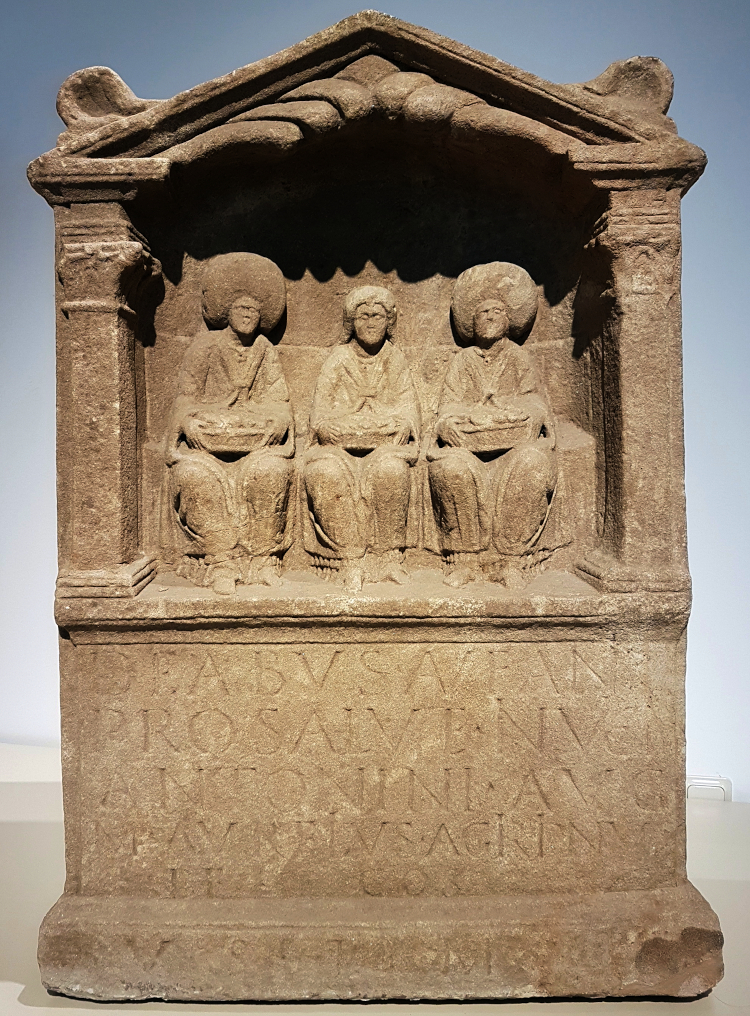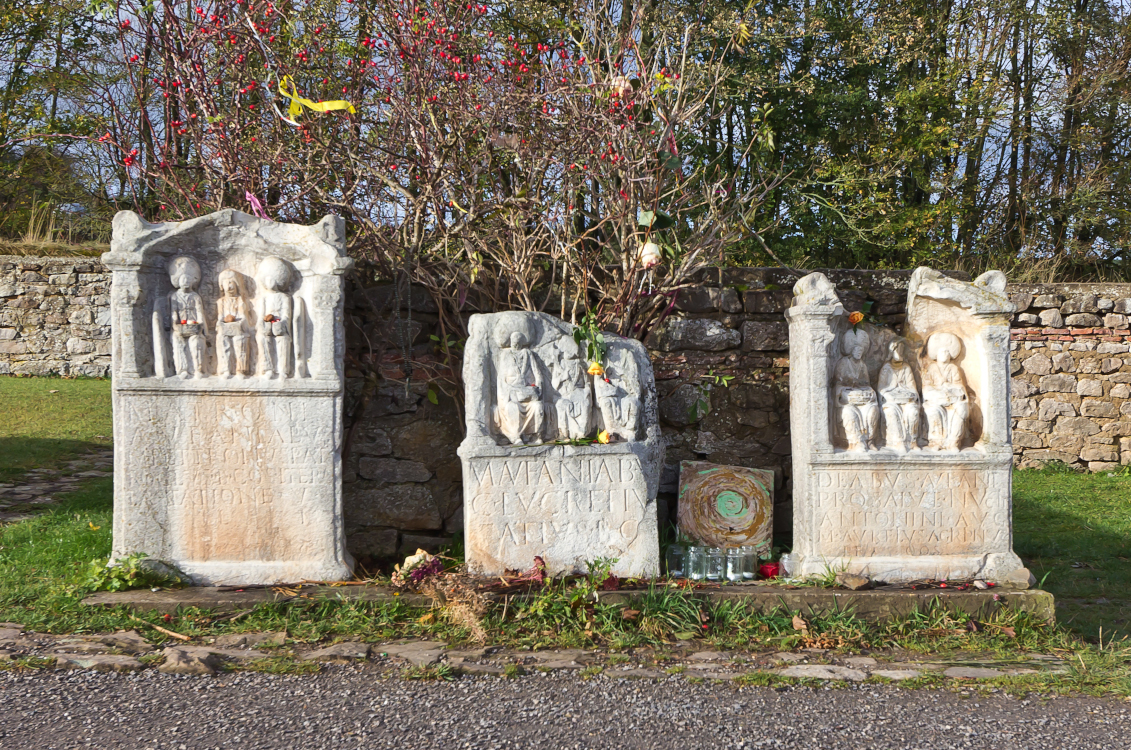MATRONIS AVFANIABVS:
to the MATRONÆ AUFANIÆ
by Viducus Brigantici filius, Cassanâ Suniciâ Sigroni, and Āgiknos Ianaanākos
2021
Introduction · Inscriptions · Iconography · Name & Etymology · Feast Day · Conclusions

Depiction of the Matronæ Aufaniæ from Nettersheim.
(Rheinisches Landesmuseum Bonn; derived from a photo by Wikimedia user User:Kleon3, CC BY-SA 4.0)
Introduction
The Matres or Matronæ are a familiar category of mother-goddesses known primarily from the Rhineland, where a profusion of ancient monuments attests to the intensity of local popular devotion to them. But Matres and Matronæ are known from throughout Gaul, Britain, and beyond. In inscriptions to them, they are frequently named with a distinctive epithet, which may have geographic or other reference. For example, a Gallo-Greek inscription from Nîmes in southern Gaul is dedicated ΜΑΤΡΕΒΟ ΝΑΜΑΥCΙΚΑΒΟ ‘to the Mothers of Nemausus (Nîmes)’.
This page focuses on the Matronæ Aufaniæ, also known as the Deæ Aufaniæ, Matres Aufaniæ, or simply Aufaniæ. The Aufaniæ are among the most widely attested Matres and Matronæ in Roman Gaul and the Germanies. We have drawn heavily from an inspection of the inscriptions and iconography mentioning the Aufaniæ in the Epigraphik Datenbank Clauss/Slaby, and therefore cite inscriptions by their EDCS IDs.
Inscriptions
More than 80 religious inscriptions to the Aufaniæ are known. Their greatest concentration is in Bonn, which in ancient times was the Romano-Germanic town of Bonna—a garrison town on the Rhine in the tribal territory of the Ubii. The Ubii, whose chief city was Cologne (Colonia Agrippinensis) farther down the Rhine, are the Germanic people of Roman Gaul most distinguished for their devotion to Matres and Matronæ of all descriptions.
Beyond Bonn, inscriptions to the Aufaniæ have been found in many other sites, including Cologne and elsewhere in the Ubian territory, notably Zülpich and the sanctuary at Nettersheim some 60 km inland from Bonn; Xanten and Nijmegen, also in the lower Rhine region; Mainz on the middle Rhine; Lyon; and even Carmo in southern Spain not far from Seville.
The Goddesses’ Style of Address and Cultic Companions
On some 49 inscriptions out of the 82 or so, the goddesses are addressed as ‘Matronæ Aufaniæ’; on some 19, simply as ‘Aufaniæ’; on 5, as ‘Deæ Aufaniæ’. The phrase ‘Matres Aufaniæ’ is used sparingly and, as it were, hesitantly: one inscription is even dedicated Matribus siue Matronis Aufaniabus Domesticis ‘to the Mothers or Matronæ Aufaniæ Domesticæ’.EDCS-11100246. This is a clear instance of domestic Aufaniæ, but it is virtually the only one; another inscription associates the Aufaniæ with the domestic mothers while evidently distinguishing them: Aufanis et Matribus Domesticis ‘to the Aufaniæ and the Matres Domesticæ’.EDCS-11202307. Likewise, the inscription from Lyon associates the Aufaniæ Matronæ with a group of Matres while making it clear that these are separate; it is dedicated Aufanis Matronis et Matribus Pannoniorum et Dalmatarum ‘to the Aufaniæ Matronæ and the Matres of the Pannonians and Dalmatians’.EDCS-10500719.
One inscription is dedicated Aufanis Sanctis and another Sanctis Aufanis ‘to the holy Aufaniæ’,EDCS-11202282, 11202284. while a third has been reconstructed to read [deabus Sanctis]simis Ma[tronis Aufanis] ‘to the most holy goddesses, the Matronæ Aufaniæ’; however, the fragmentary nature of this inscription pleads for caution.EDCS-11100050.
One of the inscriptions from Mainz is dedicated Deab Aufan et Tutelae loci ‘to the goddesses Aufaniæ and the tutela (patron goddess) of the place’.EDCS-11000706.
Dedicants and their Reasons
Those with the means to dedicate altars or other religious inscriptions necessarily skewed to the higher end of the social spectrum. One governor of Germania Inferior, L. Calpurnius Proclus, along with two women from his household furnished 4 inscriptions to the Aufaniæ. The great majority of dedicants are Roman citizens. Often they are high-status and/or soldiers of the Legio I Mineruia or other legions (some 26 dedications involve soldiers). About 10 of our 80+ dedications involve women. One decidant—evidently a Roman citizen, and possibly a civilian—identifies himself as a citizen of Noricum, where the cultus of the Matronæ Aufaniæ is not attested.EDCS-11202295. In other words, a partly transient population of soldiers, administrators, and others, coming into Bonn and its vicinity, found itself drawn to the cultus of the Matronæ Aufaniæ. It may be that such people were then responsible for continuing their cultus as they travelled onwards, for example to Spain or Lyon.
At least 37 inscriptions are votive—that is, they represent a vow fulfilled by the worshipper in thanks for a prayed-for outcome. Most of these use the common votive formula V·S·L·M for u(otum) s(oluit) l(ibens) m(erito) ‘duly and deservedly fulfilled their vow’. Beyond this, few inscriptions evoke in any detail the reasons for the dedication. Some mention that it was made pro salute sua ‘for her own well-being’EDCS-11202274. or pro se et suis ‘for themselves and theirs’.EDCS-11202282, 11202284, 11202288, 15800316, 11202297, 11202302. One dedication was made to the Matronæ Aufaniæ ex imperio ipsar(um) ‘by their own command’,EDCS-11202281. another just ex imperio ‘by command’,EDCS-11100146 indicating that the Matronæ Aufaniæ had made their instructions known through a dream, divination, or the like.
A couple of inscriptions—both at Nettersheim—use the formula IN·H·D·D for in honorem domūs diuinae ‘in honour of the divine house’, i.e. the imperial family.EDCS-11100050, 12800007. This is the most common formulaic allusion to the imperial cultus in northern Gaul. Other inscriptions are specifically pro salute ‘for the well-being’ of the emperor of the day,EDCS-36101872, 12800004, 10500719. meaning that at least for such inscriptions, the welfare of the emperor was more nearly the purpose of the dedication than a pious afterthought.

Three altars of the Matronæ Aufaniæ from the Görresburg by Nettersheim, with modern-day devotional offerings.
(Derived from a photo, © Raimond Spekking / CC BY-SA 4.0 (via Wikimedia Commons))
Iconography
Depictions of the Aufaniæ mostly fall into one of three types: one is the iconic triple seated mother motif, which we shall describe below in more detail, while the others feature an inscription and either arboreal imagery or pine-cone imagery with fruit. A fourth depiction, featuring a soldier and female captive, falls into none of these categories.
The Aufania iconography that we have surveyed all comes from Bonn or Nettersheim. Inscriptions from elsewhere are in some cases aniconic, while in others photographs were unavailable at the time of writing.
Three Seated Figures
Probably the most common iconographic type for the Aufaniæ, attested in some 16 cases, features three female figures seated side by side. Typically the figures to the left and right have the big round bonnets, almost giving the effect of exaggerated halos, that are characteristic of the Ubian region. Meanwhile, the middle figure typically has her long hair uncovered and pulled down behind her back. The goddesses normally have bowls, baskets, or platters of fruits on their laps. Such depictions also typically have tree motifs on the side panels, or in some cases a tree on one side and a pine-cone on the other.
In some cases the goddesses to right and left may be standing in front of leafy plantsEDCS-11202304 and 11202286. or accompanied by birds.EDCS-12800009. In other cases, a fourth figure might hover in the background, or the figures to left and right might both be accompanied by winged Victoria figures in the background.EDCS-11202288. In one case, a bank of three additional bare-headed female figures is seated behind the usual three, who are larger and in the foreground.EDCS-11202290. Meanwhile, the side panels may also depict figures, possibly Victoria,EDCS-11202295. Hermaphroditus,EDCS-11202274. further fruit-bearing Matronæ,EDCS-11202290. and/or others. At Nettersheim, there is in one case a pleasing shell-like motif in the tympanum.EDCS-12800004.
Arboreal Imagery
A simpler iconographic type features the inscription on the front panel of the altar, while the side panels depict trees (usually laurel, though often the two sides depict different types of trees). There are around 15 instances like this. In one case, there are birds in the branches;EDCS-36000035. in another, a vine or snake may be entwined around the branch.EDCS-11202271.
Fruited Pine-Cone Imagery
A variation on the theme of aniconic inscription on the front panel, images on the side panels, features vegetal motifs on one side (flowers, leaves, etc.) while the other side depicts bowls of fruit or cornucopiæ that are topped with pine-cones. In one case, there are cornucopiæ on either side.EDCS-11202300. One has a sculpted back panel showing a willow-tree with a goat underneath.EDCS-11202276. In total, there are about 6 depictions in this category.
The Soldier and the Captive
One very odd but arresting depiction shows a soldier standing over a captive woman, who is raising her hands.EDCS-11202285. At first glimpse, this appears to depict a soldier taking the woman captive, while she extends her hands in supplication; however, this makes relatively little sense in context. Instead, we suggest that the woman might be a captive reaching out to be rescued—perhaps a lost loved one recovered by the soldier, and thus occasioning the vow fulfilled. After all, the soldier has his shield raised, but no weapon is visible.
Name & Etymology
The name Aufaniæ can be asserted to be non-Celtic; instances of the letter F in Celtic names are vanishingly rare and as a rule are not found between vowels. The explanation of the name based upon proto-Germanic has not been clearly decided, but possible etymologies might include *ahufanējōz ‘from the rivers’ (cf. the Aufaniæ’s many attestations along the Rhine) or
*abnjan- / *afnjan- ‘to execute, fulfil, bring to completion’,Köbler, Gerhard. 2014. “*Abnjan-, afnjan-” in: Germanisches Wörterbuch. (online).
Kroonen, Guus. 2013. “Abnjan-” in: Etymological Dictionary of Proto-Germanic. Leiden, Boston: BRILL.
Orel, Vladimir. 2003. “*abnjan, *abnjanan, *abnjòjanan” in: Handbook of Germanic etymology. Leiden: BRILL.
Orel also includes meanings of the collective noun as “material, stuff, amount, measure", linking it to “riches, wealth". That overlaps with Simek’s “abundance", possibly indicating that the words are related. thus the Matronæ Aufaniæ would be the ‘matrons of achieved (or achievers of) goals, tasks, or deeds’.
Noémie Beck favours the suggested etymology
“*au-fanja- (> *au-fani-), i.e. ‘Isolated Boogy [sic] Land’ or ‘Remote Swamp’, with Germanic *fanja ‘swamp’, ‘marsh’”Noémie Beck, 2009, Goddesses in Celtic Religion, after Günter Neumann, 1987, ‘Die germanischen Matronen-Beinamen’, pp. 114-115, in Beihefte des Bonner Jahrbücher 44, Köln.
while also mentioning a derivation of “‘Lady of the area or Lady of the river’, cf. Gemanic fani, feni, ‘Valkyrie, fairy, nymph’”.Noémie Beck, 2009, Goddesses in Celtic Religion,
after H. Kern, 1873-1875, ‘Noms germaniques dans des inscriptions latines du Rhin inférieur’, in RC 2, pp. 164-166.
Meanwhile, Rudolf Simek suggested that the root was related to Gothic ūfjō ‘abundance, plenty’.Cited in Angela Hall, 2007, Dictionary of Northern Mythology. D. S. Brewer. ISBN 0-85991-513-1.
Votive inscriptions are normally in the dative—i.e., to such-and-such a deity. The dative form of Aufaniæ used in our inscriptions can vary: Aufaniabus, Aufaniis, and Aufanis are all attested on various inscriptions. Of these, Aufaniabus is the most common, occurring clearly on about 40 inscriptions, and doubtless originally on others that are now fragmentary.
Feast Day
The inscriptions in Mainz (ancient Mogontiacum, the provincial capital of Germania Superior) both mention the dates on which the altars were dedicated. One was from the year 197 CE,EDCS-71100087. the other from 211 CE,EDCS-11000706 but both were dedicated on the Ides of July, or July 15, showing that this date was of significance for the Aufaniæ at least locally. The dedication dates of altars were in many cases observed in subsequent years as feast-days, and this date was remembered at Mainz for at least a fourteen-year span before the dedication of the second altar. We therefore have ancient precedent for observing July 15 as the feast-day of the Aufaniæ.
Conclusions
The iconography of the Aufaniæ lends itself, with other evidence, to fairly straightforward interpretations of the themes that ancient worshippers found important in the Aufaniæ. Fruit and other occasional foods and livestock point to themes of abundance and fertility, whether literally horticultural or more figurative. From the trees, the soldier/captive image, and the possible snake wrapped around a branch, we may infer protection and sanctuary. The laurels and the winged Victoria figures point to themes of victory and success in attaining one’s desires. The laurel, as the tree par excellence of Apollo and the Augusti, might also indicate foresight, power, and achievement. The pine-cone typically connotes eternal life, wisdom, and/or fertility. The differences in the three goddesses’ headdresses may hint at a differentiation in their statuses—perhaps not so much ‘maiden, mother, and crone’ as mother and two grandmothers.
References
In this document is the full text of the inscriptions referred to above, as well as our notes regarding the iconography of various depictions.

En français svp !

Auf deutsch, bitte!
